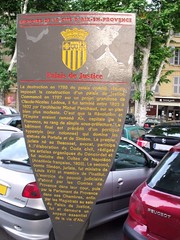Claude-Nicolas Ledoux
Commemorated on 1 plaque
Palais de Justice La destruction en 1785 du palais comtal, vétuste, imposait la construction d'un palais de justice. Commencé en 1787 sur en projet grandiose de Claude-Nicolas Ledoux, il fut terminé entre 1822 à 1833 par l'architecte Michel Penchaud, sur un plan bien plus modeste. C'est que la Révolution et l'Empire avaient ramené Aix, capitale de la Provence, au rang de simple sous-préfecture. Le bâtiment final est précédé d'un portique hypostyle (sur colonnes) qui domine les statues de Portalis et de Siméon. Le premier, juriste né au Beausset avocat, participa à l'élaboration du Code civil, rédigea les articles organiques du Concordat et fut ministre des Cultes de Napoléon (Académie française, 1803). Le second, comte Siméon, juriste, fut ministre de Louis XVIII et membre de l'Institut. L'exercise du pouvoir judiciaire, d'abord par les Comtes de Provence dans leur cour , puis par le Parlement de Provence dans ses Chambres, enfin par les Magistrats au sein du Palais de Justice, fut et demeure un aspect essentiel de la vie d'Aix.
English translation: Palace of Justice The destruction in 1785 of the old Comtal Palace required the construction of a courthouse. Started in 1787 on a grand project by Claude-Nicolas Ledoux, it was completed between 1822 and 1833 by architect Michel Penchaud, on a much more modest level. The Revolution and the Empire had brought Aix, the capital of Provence, to the rank of a mere sub-prefecture. The final building is preceded by a hypostyl portico (on columns) that dominates the statues of Portalis and Simeon. The first, a lawyer born at the Beausset lawyer, participated in the drafting of the Civil Code, drafted the organic articles of the Concordat and was minister of the Cults of Napoleon (Académie française, 1803). The second, Count Siméon, a lawyer, was minister of Louis XVIII and a member of the Institute. The exercise of judicial power, first by the Counts of Provence in their courtyard, then by the Parliament of Provence in its Chambers, and finally by the Magistrates in the Palais de Justice, was and remains an essential aspect of Aix's life. [AWS Translate]
Le Palais de Justice, Place de Verdun, Aix-en-Provence, France where they built

